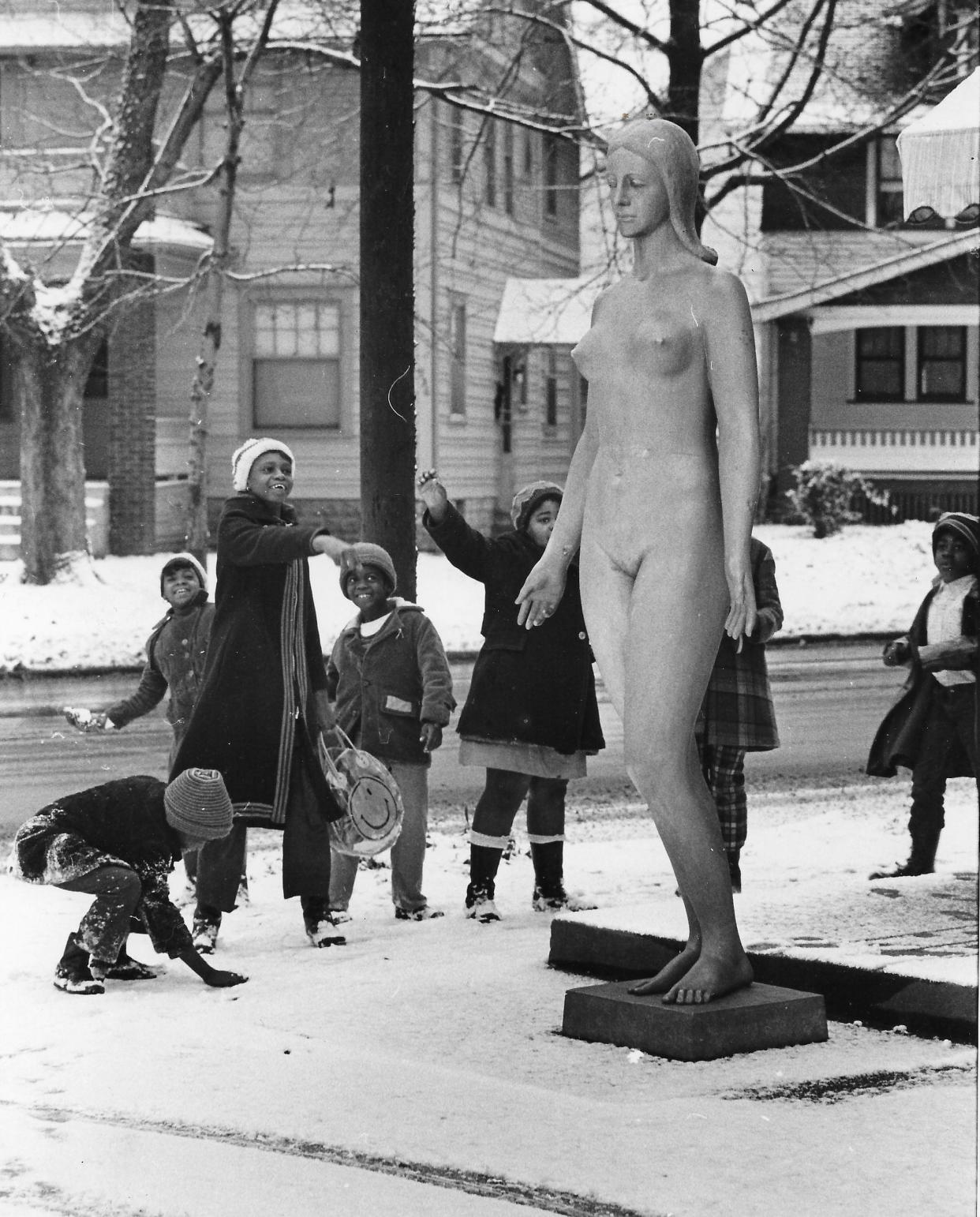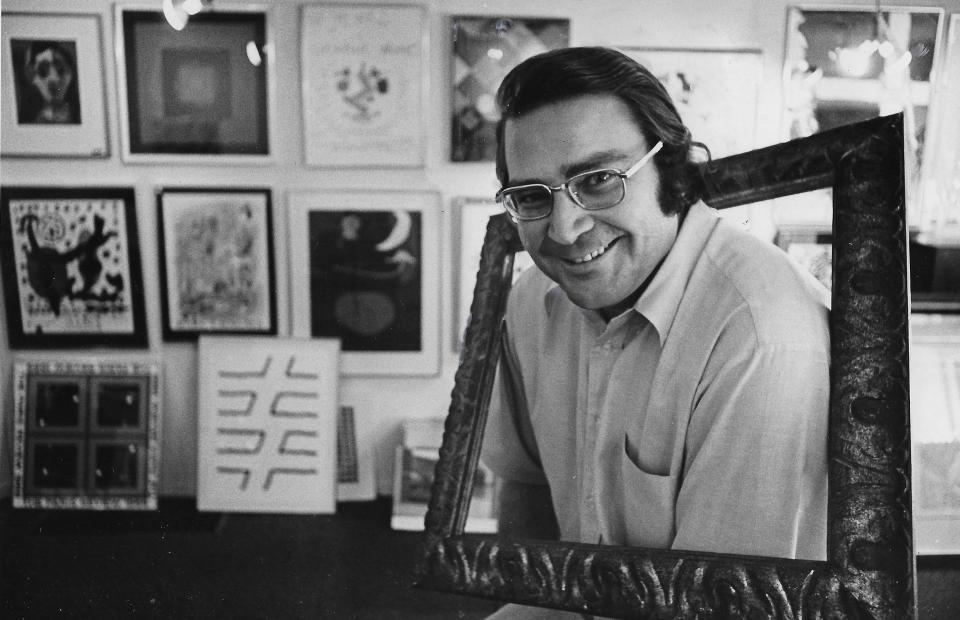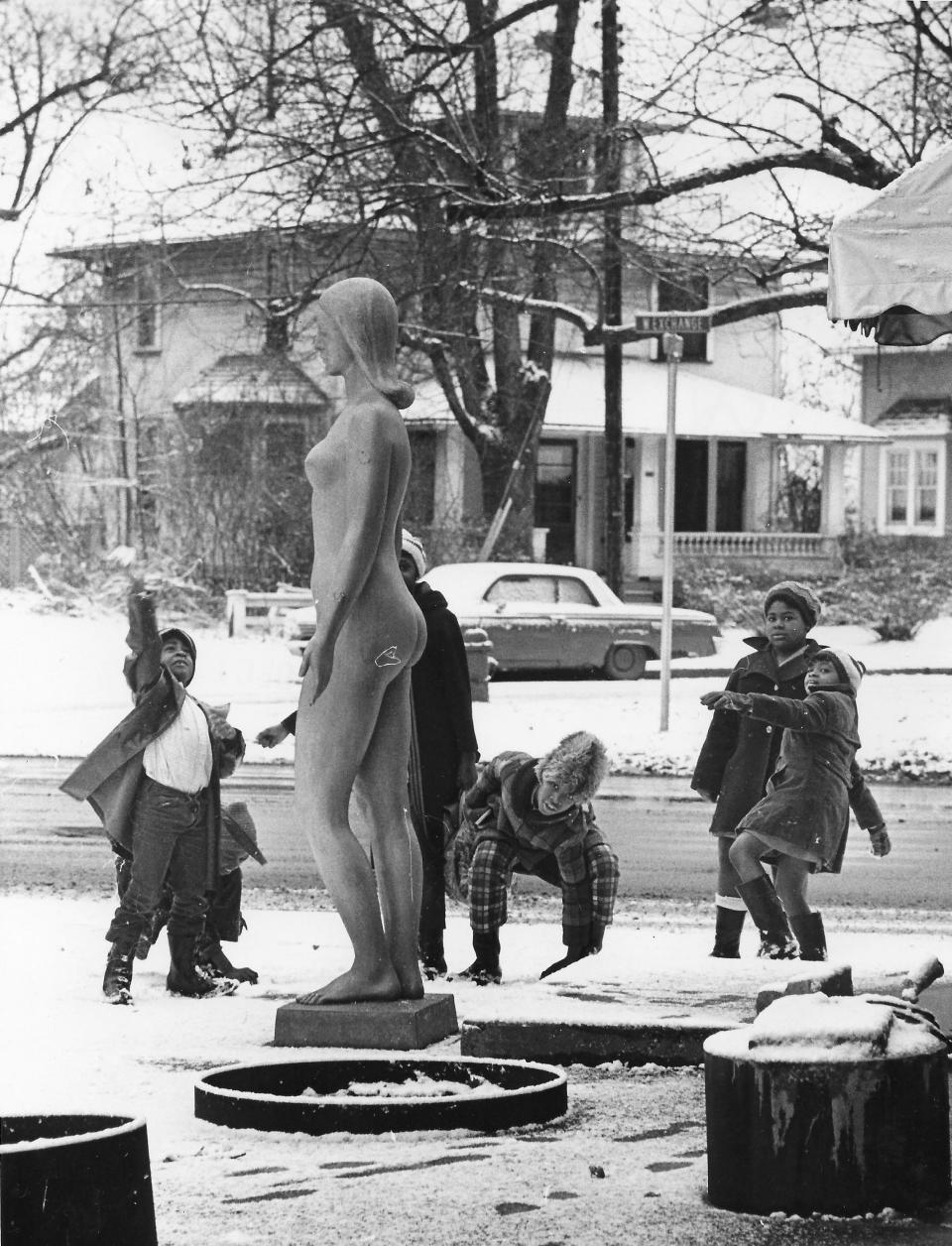Local history: Nude statue turned heads at Highland Square

That naked lady caused quite a commotion on the street corner.
Passing motorists ogled, young children gawked and protective parents glared.
She stood there quietly, eyes closed, arms beckoning, left knee bent slightly.
Occasionally, she wandered off. Then the police got involved.
Local history:Five Points Shopping Center really clicked in Akron
Akron art dealer Ray Packard turned heads in December 1972 when he placed a nude sculpture outside his Highland Square gallery at 933 W. Exchange St. The 7-foot, 200-pound figure was an eye-catching display of cast-aluminum pulchritude.
American artist Duncan Ferguson (1901-1974) created the work in 1933, naming it Minerva after the Roman goddess of wisdom, justice, law, victory, trade, the arts and probably a few other subjects. Judging by Ferguson’s undraped design, she wasn’t the goddess of modesty.
Packard Gallery was hub of arts
The Packard Gallery was Akron’s answer to The Factory, Andy Warhol’s studio in New York City. It was a local hangout for cutting-edge artists and musicians as well as a place to purchase or admire original paintings, sculptures, drawings and prints.

The gallery opened in 1962 on South Howard Street in downtown Akron before Packard relocated in 1966 to a former corner grocery at West Exchange and Grand Avenue.
“There's tons of stories about the old Packard Gallery, with Chrissie Hynde framing pictures in the basement and DEVO jamming away upstairs,” son Raynard Packard recalled. “Minerva stood as silent sentinel to quite a hub of activity.”
No place like Devo:Gerald Casale revisits childhood home in Kent
The sculpture may have arrived with an exhibit of Ferguson’s work when the artist lived in Cleveland. Minerva had been appraised for $15,000 (about $103,000 today) at a previous display at New York’s Whitney Museum of American Art.
That was a lot of money to leave on the sidewalk, but that’s essentially what Packard did. Minerva was designed as an outdoor sculpture.
“That’s the way she’s meant to be seen,” Packard insisted. “It’s that simple.”
Besides, it took two or three people to move her inside, so the gallery just let her stay out front. It’s not like she was going to walk away, right?
Minerva certainly drew attention. Drivers slowed to take a look at the well-proportioned figure.
“I like to think she’s welcoming the rubber workers on their way home out Exchange,” Packard said.
Cheers and jeers for 7-foot nude
Students got an eyeful while walking to Portage Path Elementary School. Some kids giggled and pointed. Others pelted the aluminum giant with snowballs.
The gallery received several complaints about the outdoor display, mostly from moms who were concerned that Minerva was corrupting public morals.
“As a mother of two little boys, I am appalled at what the Packard Art Gallery seems to be getting away with,” Deborah Valloric wrote in a Dec. 8, 1972, letter to the Beacon Journal. “There are more small children viewing this piece of art than adults.
“I am certainly glad that it is not my children that travel back and forth to Portage Path School. Our society exposes children to enough bad without having to do something that is entirely unnecessary. What is Mr. Packard thinking of, the minds of grown men or the minds of small children?”
Support local journalism:6 reasons why you should subscribe to the Akron Beacon Journal
The following week, Judith Littman responded with a letter in favor of the artwork:
“I would like to say a few sentences to the mother who objects to the statue in front of the Packard Gallery. 1) Art is not obscene, it’s beautiful. Would you call Michelangelo’s David crude, naked and ugly? 2) If you are worried about young children, have you seen the new Barbie dolls?”
Where did that statue go?
Minerva stood naked and cold that winter. Then one night, she vanished.

Packard reported her missing Feb. 17, 1973. He couldn’t understand why people would take the sculpture. They couldn’t possibly get away with it.
“I’m wondering how, in this environment, theft — even as a lark — can be condoned,” he said. “They can’t hide it, or keep people from knowing they’ve got it.”
Sure enough, Minerva was found unharmed that afternoon, lying on her side in the snow at Sand Run Metro Park. She returned home safely to the gallery.
Police urged Packard to move the statue inside, but he resisted.
“There’s no place inside where she’ll fit,” Packard said. “Besides, she’s meant to be displayed outside.”
And inevitably she disappeared again.
Three teenagers abducted the goddess late Nov. 29, 1973, stuffed her into the back of a station wagon and took her on a joy ride around Akron. Police got suspicious at 2:30 a.m. when they saw the vehicle pull into the Brown Derby at South Main Street and Waterloo Road with a naked sculpture sticking out the window.
Minerva returned home for a while. Then she took another ride with strangers.
Mischief makers grabbed her after midnight on Oct. 17, 1975. Tallmadge police found the statue later that day, dumped unceremoniously near the entrance ramp to Interstate 76 at Southeast Avenue. She wouldn’t fit in a cruiser, so Packard had to go retrieve her with a van.
Another short-lived heist occurred after 10 p.m. Dec. 4, 1976. An Akron patrolman noticed two young men trying to cover a naked statue in a trailer on Crosby Street. Upon questioning, they admitted they were Ashland College students conducting a fraternity prank.
They had been told to bring back “something odd” to Ashland, and the 7-foot nude certainly fit the bill. The college boys were apprehended only 10 minutes after taking the sculpture.

Any publicity is good publicity
Other abductions apparently weren’t reported in the media.
“Ah yes, Minerva,” Raynard Packard recalled. “I remember she would be periodically stolen, typically as a fraternity prank, often winding up in the most incredible of places: upside down on a freeway overpass, atop the First National Tower, etc. She had a thumb snapped off at one point.”
His father declined to press charges when authorities caught the aluminum bandits.
“He explained to me, ‘There's no such thing as bad publicity,’ ” Raynard explained.
Local history:Local history: Statue is a giant in Goodyear’s success
The Akron arts scene suffered a major dent in July 1977 when Packard closed his West Exchange Street gallery after a huge clearance sale
He moved to Venice, California, where he lived with sons Vincent, Raynard and Damon.
Minerva didn’t go along for the trip, although she would have fit in with the crowd on the Venice boardwalk.
“If memory serves me correct, she went to a collector on the East Coast,” Raynard noted.
She no longer takes joy rides in Akron.

The former gallery still stands. The grass-roots mission City Hope purchased the vacant two-story building in 2014 for $16,500 and named it the Grand Exchange as a community resource center “for the common good.”
University of Akron art students covered it with murals in 2019, a nice tribute to the past.
Ray Packard, an accomplished painter and teacher, was 87 when he died July 12, 2020.
“My father was always the coolest guy in the room,” Raynard said.
Wherever Minerva is today, we hope she’s still turning heads.
Mark J. Price can be reached at mprice@thebeaconjournal.com.
Local history:The night the Akron Art Institute burned
This article originally appeared on Akron Beacon Journal: Nude statue caused commotion in 1972 at Highland Square gallery

